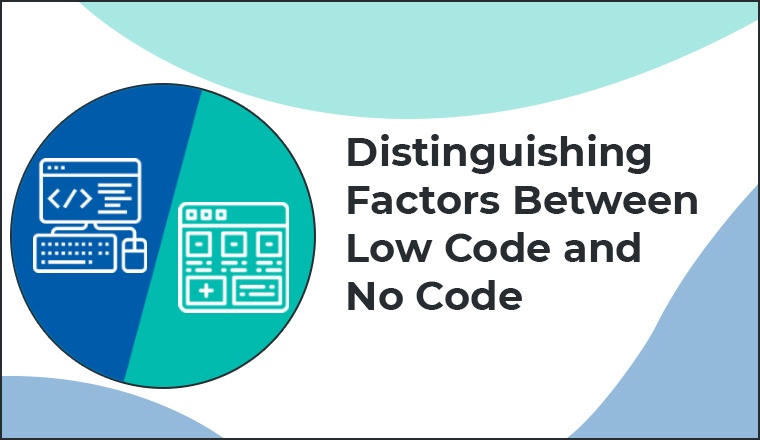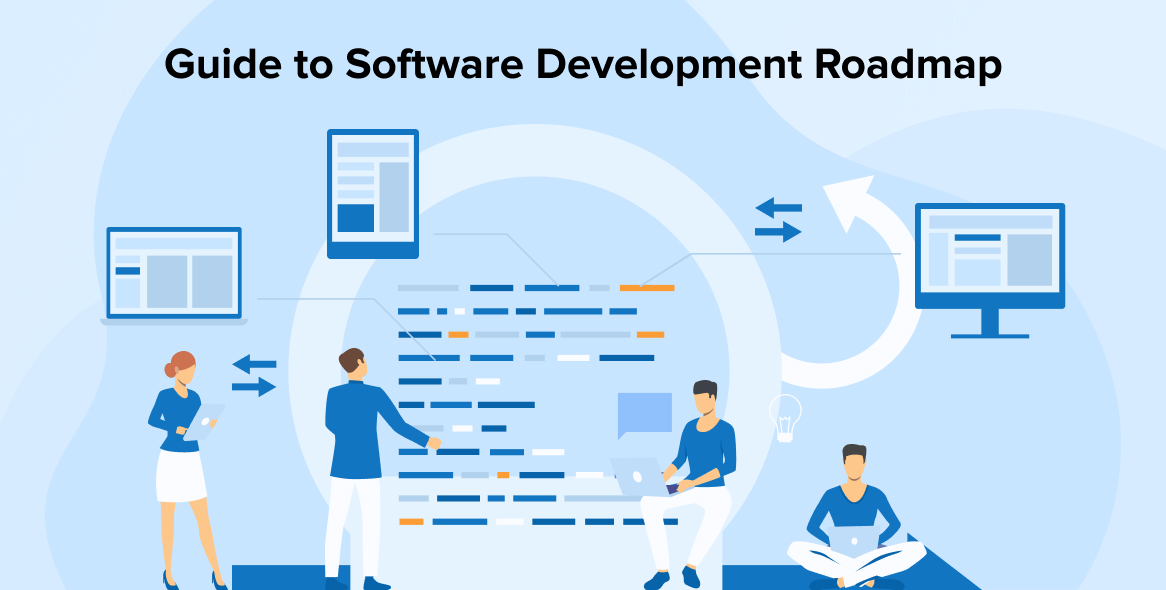
The world of software innovations is snowballing with lightning speed web apps for more convenience for customers. There is a prediction by Gartner that by 2024, there will be more than 65% of app developments dependent on low-code application development platforms. If we were to look at this prediction, there are two large built segments that come to your mind: the low code and no code industry. If we look at both these industries they are connected to each other with visual modeling. Both these approaches used by software development companies for coding are separated by a thin line which will be discovered in low code vs no code blog sooner. Superficially both these technologies will confuse the citizen developers and business owners and they might not clearly get the difference.
So, if we put aside all the ambiguity, there is still so much speculation about low code and no-code being the same platforms. It is not the same. They are two different platforms, if we were to differentiate between the two then we can say they are different from each other in multiple aspects. You can make out the difference from the interface level and can burst out all other myths from that level itself. Even if you couldn’t see a visible difference, there are a few vital differences that are only viewed when discussed deeply. Hence, this blog post will showcase all the pertinent differences between the two so that your business owners understand which one will suit them the best.
So, before focusing towards the low code vs no code development aspects, firstly let us talk about the definition of both these coding approaches.
1. What is a Low Code? How Does it Work?
Low-code application development means less code. This means the process of developing software with less code and lesser manual effort.
Low-code solutions give IT teams the ability to assemble and build blocks of existing code and convert it into automated workflows and apps. These contributing aspects get the code behind actions and commands, which enables to create business apps and unique processes without the need to code them manually. Robust security processes, data integration, and cross-platform support are all built-in and can be quickly customized with lowcode.
The functioning of Low-code development platforms is like it allows all professional developers to work smarter, better and faster than any other coding approach. This is because they are not restricted to using specific code sets and are free to use repetitive coding or repeating work. Instead, the development teams concentrate on the 10% of an application that sets the whole app apart. They work on its coding, architecting, or developing it using their programming knowledge, technical expertise and delegating the hard work to a low-code platform.
Also, in the past few years, the rise in the number of software development tools and technologies available for enterprises has expanded substantially. As a result, rather than managing monolithic stacks, IT staff now manages diverse, complex ecosystems. This is the impact of low code and IT has evolved in line with those conditions, resulting in a low-code platform for java developers.
Today, if you want to rely on custom scripts, it may or may not fulfill the speed and agility requirements of enterprises. And plus if you add customization it contradicts the most generic cross-platform operations. When it comes to low code tools, only a few developers have hands-on experience with all of the tools used in a given end-to-end method. Thus, there is a demand for low code developers in the market.
2. Advantages of Low Code
Low-code and No code development refers to a set of tools that can be used to create anything from business software to IT procedures. Here are some of the common features that they both have including direct API access, low-code integrations, workflow prototyping, and testing offers.
There are several advantages of low-code development tools because of the services they offer like monitoring, resource management, and additional capabilities that help streamline DevOps, depending on the platform. If you want to deploy a flow-code development platform, it will offer a variety of advantages to your company:
2.1 Improved Efficiencies
The process that used to take months is now done in days and the credit goes to low-code development. It can boost the speed of app development for multiple platforms simultaneously to be produced in less time. Time is no longer considered a reason for developing more applications. For example, we see people saying since we don’t have time, we are not developing this app.
2.2 Better Customer Service
Low-code development has alterations in other departments as well. An app journey goes from one department to another. A bad customer experience can also be one of the worst impacts of increased speed. So, don’t speed up, focus on the quality of the app too. Organizations can swiftly respond to market changes or consumer needs with the help of low-code platform development.
2.3 Enhanced Agility
The majority of low-code systems are scalable, this allows you to turn APIs into web services, and command lines into reusable building blocks. There are also direct connections that are built with all third party suppliers. By decreasing the time spent, they can now easily integrate and deploy new tools and technology, while the enterprises can stay ahead of market developments as well as customer expectations. And Low code development platform helps businesses to achieve this and gain a competitive edge.
2.4 Cost Reduction
Cost is an inevitable part of the software development process. The cost is reduced as a result of the capacity to construct more apps in less time. But that is not the only thing, Low-code development can help you minimize the business needs of additional software developers by lowering the cost of recruitment and even infrastructure.
3. What is No Code and Its Functioning?
As the name implies, we know that the actual meaning of no-code application development is using minimal codes. It is a method to create apps without having to write code. No-code development platforms allow professional developers to create powerful, enterprise-grade applications by dragging and dropping pre-configured components.
No-code platforms use technology to empower rather than hinder individuals’ abilities to develop by allowing them to construct applications without knowing how to write.
In some ways, the term “no-code” is misleading because it makes you believe that there is no single code involved but that’s not the case. There is massive coding involved, but it is hidden from view by business users. Such heavy tasks are prepared by no-code tool providers. Since they know how to utilize data abstraction and encapsulation for their codes. This will effectively hide the complexity for the users and let you achieve results by simply dragging and dropping application components to build an app.
Just like low-code development, No-code development also functions in a visual integrated development environment. They commonly use a model-driven development technique, in which a software model is used to sketch out how the software system should work before any coding takes place.
4. Advantages of No Code
No code application is full of advantages if you know how to leverage the benefits. Other applications use Metadata to keep the application maintained with codes. While no code is authentic and fully functional even with the newer versions of the app. There is a list of advantages that no code solutions offers to developers and some of them are as below.
4.1 Rapidly Integrate Changes
In most cases, professional developers may need to update code in the process of development due to altering market demands. This is a time-consuming business process, it takes time and money, and it’s tough to do in traditional programming languages. With the help of no-code tools, skilled developers can easily integrate modifications and extend the functionality of their applications as needed. It becomes fast and the development process is streamlined as a result, and the time-to-market is greatly reduced.
4.2 Application Delivery in a Flash
Businesses can construct applications faster using a no-code platform than they can with traditional coding approaches. Because they don’t have to hand-code each line of code, developers can cut down on development time.
4.3 Better Change Management System and Agile Operations
Since this approach doesn’t involve or demand any coding expertise, it’s one of the quickest ways to build an app. As there is less coding, the company can benefit from automated systems. If you wish to make a change to an app that you created using the no-code development platform, you may do it quickly and effortlessly.
4.4 Minimal Cost Spent on Cost of Ownership (TCO)
The simplest way we can say that a no-code platform is a low-cost alternative to traditional coding. It will help you address your digital demands while also making an effort to reduce organization’s time, money and efforts. As no-code platforms may not require the same amount of effort as traditional coding platforms, the organization’s workload can be greatly minimized.
5. Distinguishing Factors Between Low Code and No Code

| Category | Low Code | No code |
| Target users | Low code platforms are aimed to simplify developer’s tasks. Hence developers are the first users and targeted audience. | No code platforms target business users and owners. It’s important to make them understand how no code can bring a difference. |
| Trade-offs | Many Low code platforms function on a small amount of code and so you need a professional to code and build a variety of applications. | No code focuses on abstract technical issues. If you are thorough with what you want you can easily use the platform for easier app development. |
| Version concerns | Custom code that is utilized will be affected by any new version. It changes how the platform functions because it now works differently. | There is no change in codes even after version updates of no code tools. |
| Compatibility | It is compatible if you change some codes and make it custom. | It is compatible across all devices and platforms. |
6. Similarities Between Low Code and No Code
The only reason both these coding approaches are interchanged often is because they have a lot of similarities. Both the platforms- Low-code and no-code development enables your business to create software applications without writing any code. The most common thing is that they both take the help of visual design tools for an approach to rapid application development rather than learning any standard programming languages. The reason that professionals will gain more benefits from this is that both of them help to create applications more efficiently and rapidly. Thus, there is an increase in productivity. It is also capable of offering Platform as a Service.. The main benefits that you can achieve from such environments is saving on some extra overhead costs, environment setups, and enhancing the existing development platform.
This opens up gates to a variety of app development methods and options to a wider range of people.
7. Conclusion
The closing thoughts on Low code vs No code is that both these technologies are already blooming and ready to take over the task of manual coding. This will sway away from the manual coding efforts and moreover, automation will take place. Both these rapid application development platforms have the ability to build software solutions that best fits enterprise workflow. Every developer or user will now be able to build apps not in years, months or weeks but in hours and days. Focus on which one would benefit your business the best and make the most of it.






Comments
Leave a message...